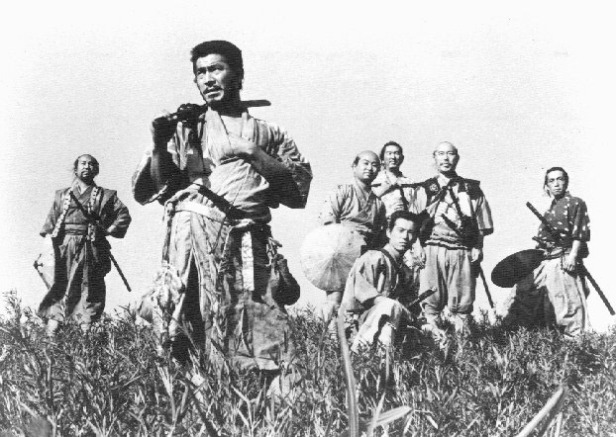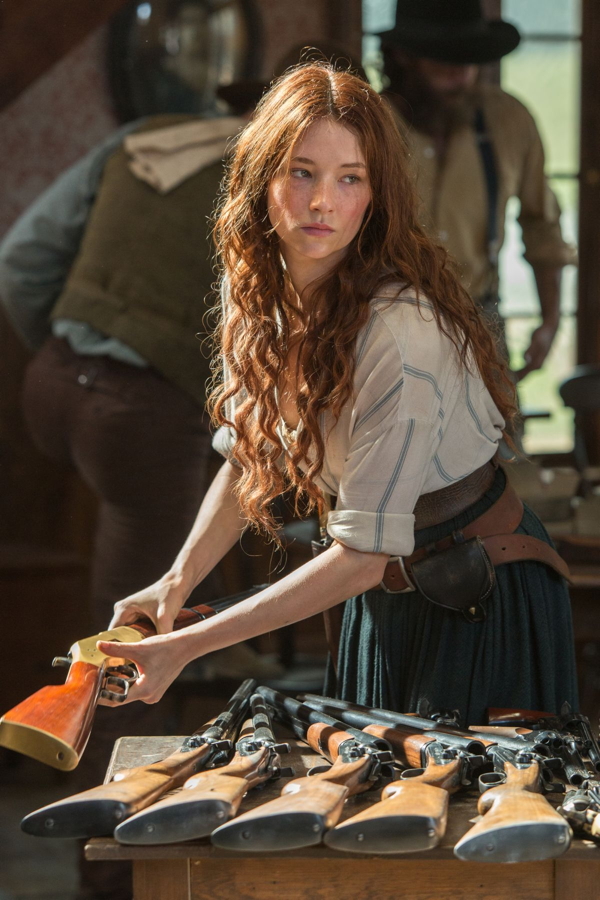

The new version of The Magnificent Seven is an entry in a major global franchise. The universal elements in the film’s story have been around for a very long time. Robin Hood, for instance, is a story in which a group of outlaws protect villagers from the Sheriff’s men. But the specific story structure of seven ‘professionals’ recruited to protect a village comes from the imagination of Kurosawa Akira and his collaborators and the folk tales and history of 16th century Japan that created the 1954 film Seven Samurai, widely regarded as a classic action film. Seven Samurai prompted the original Hollywood remake in 1960 and several sequels. In his chapter on ‘Remaking Seven Samurai in World Cinema’ in East Asian Cinemas (eds Leon Hunt and Leung Wing-Fai, I. B. Tauris 2008) David Desser explores the influence of the film on a range of productions in Hong Kong and India as well as in the US. My interest is in the extent to which the new film draws on Kurosawa and how much is lost through the process of adaptation. The scriptwriters of the new film, Nic Pizzolatto and Richard Wenk, are credited alongside the original writers Kurosawa, Hashimoto Shinobu and Oguni Hideo. I note that Pizzolatto is a novelist who has written for the TV serials True Detective and the US remake of The Killing, and that he has also taught writing – all of which might give some hope that he could make good use of the original script.
There are certainly aspects of the original script still present, but the new film is 133 mins long, roughly 65% of the running time of the Kurosawa film, so quite a lot is missing (there is no ‘padding’ in Seven Samurai). The location of the story has moved north from the 1960 version and re-located in the Sierra Nevada (“three days from Sacramento”) in 1879. This makes sense since Seven Samurai was similarly based in the mountains in an isolated village. The date and setting make the new film a ‘mountain Western’ with gold mining. Here is the first problem in that the townspeople of Rose Creek don’t have a visible farming community and their attachment to the land is symbolic rather than being portrayed realistically. (In the original, the bandits have already been to steal the rice harvest and are expected again for the barley harvest.) The new script isn’t quite sure what to do with the gold miners and it doesn’t have time (or enough imagination?) to represent farming. Instead it introduces the villain as a capitalist exploiter and the main motivation of the townsfolk to be expressed through Emma (Haley Bennett), a woman who wants “righteousness” after her husband was killed by the exploiter “but will take revenge”. A similar figure was a minor but important character in the original. Apart from the preacher, none of the other townspeople is given a narrative function as such. Because of this, Kurosawa’s main theme is lost.
Seven Samurai is about a distinctive clash of caste and class presented as a humanist epic. The farmers in the isolated village normally despise the samurai, whose societal role as warriors employed by feudal lords is under threat during the 16th century when many of them are unemployed, becoming ronin or ‘masterless samurai’. The samurai who are recruited to help the farmers are poor and hungry – they will fight for three bowls of rice a day. But they are also men of honour, so they will fight to maintain that honour. Kurosawa makes this explicit and deeply moving by a decision to employ what was already becoming his trademark, the ‘master and apprentice’ roles within the group of samurai. Shimura Takashi as Kannei is the ‘master’, the older man who is a wise warrior, a skilled fighter and a leader of men. Katsushiro (Kimura Isao) is the young man, the devoted follower and the one with most to learn because he is distracted by a young woman from the village. Shimura was the actor used most by Kurosawa. But he isn’t the star of the film. That’s Mifune Toshiro. Mifune plays Kikuchiyo, the man who would be a samurai. His secret will only emerge later when we learn that he was a farmer’s son and that he had been abandoned as a baby during a raid by pirates. Kikuchiyo forms the bridge between the samurai and the farmers. He understands both and despises both, yet supports both. It is his human story that reveals the film’s theme. The genius of the Seven Samurai script is that we learn about a wide range of characters – so there are individual stories – but those stories also inform the overall narrative about a society in which both farmers and samurai/bandits are suffering (but in which the farmers will be the long-term winners).

The script for the new film struggles to find the same sense of coherence. We do learn something of the ‘back stories’ of ‘Chisolm’ (Denzel Washington) Goodnight Robicheaux (Ethan Hawke) and a few others, but these stories don’t relate to the overall narrative in the same way as they do in Kurosawa’s film. Chisolm does have a personal reason to fight, but like Emma’s motivation it is about revenge against the villain, not about honour. Revenge is not a motive to trigger carnage on the scale depicted here. At the end of the Seven Samurai, the three survivors are the ‘master’, the ‘apprentice’ and the second in command. The other four samurai have been killed and the master observes, as planting begins for a new crop, that the farmers have won. I suppose I shouldn’t spoil the ending of the new version, save to note that what it seems to do is to highlight the new ‘diversity’ amongst the defenders of the village. Yet the weirdest thing about the whole film is that presence of a black law enforcement officer (Chisolm), an East Asian gunslinger, a Comanche warrior and a woman leading the townspeople is never really commented upon. Director Antoine Fuqua has said that he wanted to make the kind of Western that he watched as a child with his grandmother. In this sense his film is ‘colour-blind’. But this is a film set in that period of Western history when the four ‘minorities’ he presents in the narrative were actively engaged in conflicts in the ‘real West’ as well as the Hollywood ‘revisioned’ West of movies from the 1970s onwards. It’s as if movies like Harry Belafonte’s Buck and the Preacher (1972) never happened. In The Magnificent Seven we see the gamblers and saloon girls leaving town when the attacks begin, but in McCabe and Mrs Miller (1973), the brothel-keeper played by Julie Christie is a new kind of female entrepreneur to stand alongside the school teacher and the homesteader as a new female type – and a representative of capitalist enterprise. Instead of running away she would consider selling out to the kind of capitalist exploiter who threatens the town in the new Seven. The East Asian character is again not investigated in any way, even though 1879 was some 10 years after Chinese workers had helped build the first transcontinental railway in the US. Chinese migrants (and therefore East Asians generally) would have been part of the life of many Western towns. I’m not sure how a Korean would have got there, but the point is that Fuqua seems fairly cavalier about both ‘real’ history and the myths developed during the declining years of the Western as a mainstream genre. By contrast, Kurosawa’s historical representations were essentially ‘realist’ with careful research to get things ‘right’.
Kurosawa famously built his village in the mountains, for the most expensive film in Japanese history at that point. He built it to specifications with the various action sequences in mind. Fuqua presumably built his own town on location for the same reasons. Unfortunately he doesn’t seem to have thought so much about how to shoot the action scenes. The only thing I remember from the great battle is the bizarre sight of Denzel Washington performing a riding stunt worthy of a Roy Rogers movie in order to shoot a bad guy. Fuqua did choose to have a church at the centre of the action and this was a good decision, conjuring up a whole host of Westerns, but again I don’t think it was thought through fully. Kurosawa set his battle in the midst of howling winds and torrential rain with swordsmen struggling in a sea of mud to great effect. Nothing as exciting happens in the new film. However, I should record that I actually enjoyed watching Denzel and co. even as I was ticking off the missed opportunities. The film was entertaining, it just wasn’t ‘special’. Seven Samurai still stands at No 19 on IMDb’s all-time list of the Top 250 movies and for good reason. It has a great story, human values, engaging characters, terrific performances, photography and editing rarely bettered, a wonderful score and Mifune on fire. See the trailers below for a quick summation of the differences.

The Magnificent Seven had a brief stopover in IMAX at Bradford, when the only other people watching it while I was there were two couples in their senior years who must have been eager to compare it with the ‘original’ where Steve McQueen was preoccupied in stealing scenes from Yul Brynner by flexing his hat. Nonetheless I found it quite enjoyable watching all the ancient tropes of this kind of oater resurrected, such as the coward fleeing before the battle then making a triumphant return guns blazing scattering the enemy before him. This sudden return of bravery always precedes an early death though. Also there was the enjoyable old chestnut where you hear guns blazing in the saloon followed by one of the bad guys slowly walking out, only to collapse in a heap seconds later. There was much to enjoy in this film for me, and I was surprised to see which three survived at the end of it. Having said that, I think I would rather have seen Silverado or High Plains Drifter again. There was nothing new here and not much to think about.
LikeLike